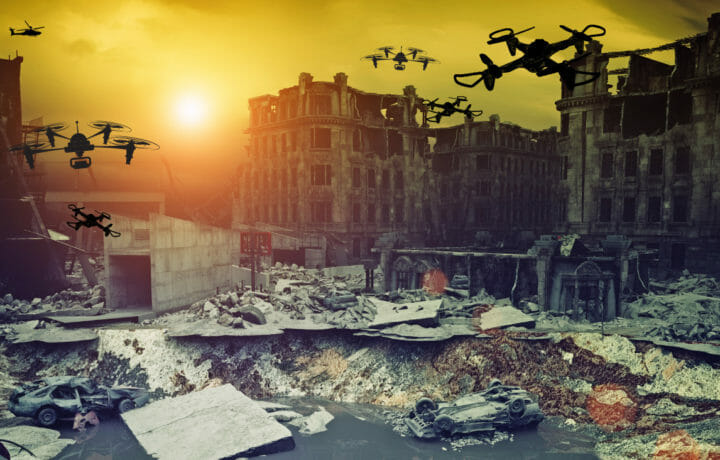The ability of a small group of people to create widespread harm. That is something that anyone who was alive during the September 11 attacks and the aftermath can relate to. But what does the future of terrorism and their weapons of mass destruction look like? As we reflect on 9/11 and the legacy of 20 years as troops are pulling out of Afghanistan, ClearanceJobs had a conversation with Zachery Kallenborn whose job is to ask these complicated questions and find hypothetical answers.
Kallenborn has long been interested in the why to evil scenarios. He also double majored in math and international relations, minoring in German physics and history. Him enjoying staying busy, constantly running away from boredom, or continuously chasing curiosity is an understatement. But luckily threats in national security are dynamic enough for his mad scientist mind.
THE FUTURE OF AUTONOMOUS WEAPONS: DRONE SWARMS
Drone swarms: Multiple drones working together and collaborating. It sounds like science fiction, but it is in fact happening IRL. These swarms are working together autonomously and were originally designed by Massachusetts Institute of Technology (MIT) engineering students [Perdix], modified for military use.
Artificial intelligence shows no signs of slowing down, and the DoD is pushing the envelope for the research and development behind it. As unmanned aerial vehicles – UAVs or drones – grow in their capabilities (like insect size swarms developed by, you guessed it, MIT students) we may just see it be introduced to modern warfare or espionage tactics.
Kallenborn’s current drone research is with the Naval Postgraduate School studies, tackling what growing these swarms means for the broader national security, and how to mitigate some of the risk these weapons create (i.e. drone swarms and AI not being able to detect between military and civilian targets). What will this scalable harm from hundreds to thousands of drone swarms do to societies amidst war?
JOBS IN CBRNE AND WEAPONS OF MASS DESTRUCTION
Interested in a career for CBRNE missions or combatting WMDs?
Nerve gas, tear gas, viruses, bacteria, anthrax, nuclear bombs, and drone swarms. Keeping the U.S. safe from these dangers has been a topic of news for some time, and the agency missions under this umbrella encompass a variety of roles that you can train or study for, including ones like Kallenborn’s.
For example, increasing the autonomy of weapon systems (AI, machine learning, etc.) are applicable to every aspect of warfare, both conventional or that are applicable to current jobs or ones that are more theoretical like researching future threats or uses. There are many federally funded R&D programs – close to academia but that are relevant to actual policy – that you can apply for. Organizations like RAND, MITRE, Center for Naval Analysis, or any national labs are good options.
Kallenborn advises that national security can arguably be the most interdisciplinary career: studying or working in terrorism can mean you focus on the psychology behind it, the scientific components, the policy to prevent or combat it, or the religious / ideological values that motivate it and how it fits in with greater diplomacy.
WHY IS IT THAT PEOPLE DO THESE HORRIBLE THINGS?
Kallenborn tries to answer the question, while analyzing the horrible ways people kill one another: drone swarms, weapons of mass destruction, and apocalyptic terrorism. His work has been published in a wide range of peer-reviewed, trade, and popular outlets, including Foreign Policy, Slate, War on the Rocks, and the Nonproliferation Review.
Officially, Zachary is a Research Affiliate with the Unconventional Weapons and Technology Division of the National Consortium for the Study of Terrorism and Responses to Terrorism (START), a Policy Fellow at the Schar School of Policy and Government, an officially proclaimed U.S. Army “Mad Scientist,” and Senior Consultant at ABS Group. He has approximately five years in federal government consulting, conducting risk assessment, futures analysis, doctrine analysis, organizational strategy assessments, systems thinking analysis, literature review, and open source research for numerous offices within the Departments of State, Defense, Commerce, and Homeland Security.
Don’t forget: Subscribe to the Security Clearance Careers Podcast this month to benefit The American Legion’s 100 Miles for Hope campaign!






